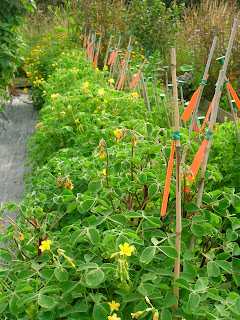Flower buds, I mean - oca flower buds.
The unsummery weather we've had until fairly recently, with heavy rain and strong winds, doesn't seem to have fazed the ocas at all. They're keen to give their all in the Reproduction Sweepstake. I'll just have to follow on behind as per usual, with little envelopes to collect the output of the random oca generator.
Flowers have been appearing sporadically for a couple of weeks, but it looks like the high season is now upon us. I can see plenty of my 100+ plants with plenty of flowers. Let the riotous season of cross pollination commence.
One concern I have is the relative scarcity of bumble bees so far this season. I'm pretty sure that Oca Acres was fairly ringing to their buzzing last year. This year is different: hardly any were to be seen until the last couple of weeks. I don't think I even glimpsed a single honeybee until a few days ago, which is highly unusual. Apart from my obvious worries about the decline of well-loved insects, I don't really want to go back to the dark (daft?) days of hand pollination if I can avoid it. The bees and hoverflies seemed to do a much better job than me without the general tetchiness and backache I experienced when transferring pollen.
I notice that one of my self-sown seedlings is now in flower. This isn't Prima, but the second plant to appear, henceforth to be known as Compay Segundo. If this and other similar seedlings flower and set seed, the whole oca lifecycle will have been achieved alfresco - another step in the long road to acclimatising the plant to our conditions.
And here's a sight you don't see very often: volunteer seedling ocas appearing as the understory amongst some rocoto chillies (Capsicum pubescens). If this sort of polyculture cropping appeals to you, head to the Growing Oca blog, where Ian seems to have perfected the art of oca associations in the vegetable bed. In the meantime, I'll keep plugging away at finding a day- neutral, heavy yielding, tasty and ravishingly beautiful oca. Wish me luck and never mind that it's started raining again.
The unsummery weather we've had until fairly recently, with heavy rain and strong winds, doesn't seem to have fazed the ocas at all. They're keen to give their all in the Reproduction Sweepstake. I'll just have to follow on behind as per usual, with little envelopes to collect the output of the random oca generator.
Flowers have been appearing sporadically for a couple of weeks, but it looks like the high season is now upon us. I can see plenty of my 100+ plants with plenty of flowers. Let the riotous season of cross pollination commence.
One concern I have is the relative scarcity of bumble bees so far this season. I'm pretty sure that Oca Acres was fairly ringing to their buzzing last year. This year is different: hardly any were to be seen until the last couple of weeks. I don't think I even glimpsed a single honeybee until a few days ago, which is highly unusual. Apart from my obvious worries about the decline of well-loved insects, I don't really want to go back to the dark (daft?) days of hand pollination if I can avoid it. The bees and hoverflies seemed to do a much better job than me without the general tetchiness and backache I experienced when transferring pollen.
I notice that one of my self-sown seedlings is now in flower. This isn't Prima, but the second plant to appear, henceforth to be known as Compay Segundo. If this and other similar seedlings flower and set seed, the whole oca lifecycle will have been achieved alfresco - another step in the long road to acclimatising the plant to our conditions.
And here's a sight you don't see very often: volunteer seedling ocas appearing as the understory amongst some rocoto chillies (Capsicum pubescens). If this sort of polyculture cropping appeals to you, head to the Growing Oca blog, where Ian seems to have perfected the art of oca associations in the vegetable bed. In the meantime, I'll keep plugging away at finding a day- neutral, heavy yielding, tasty and ravishingly beautiful oca. Wish me luck and never mind that it's started raining again.



Comments
I also have summers for Rocotos, with that cool weather them seem to need. I should try it. The main issue is that I'm zone 7 so I couldn't do in open ground. In that case, they'll need large pots to move inside for winter. The second is that mild varieties are not common in C. pubescens. I do like tasty volcanic C. chinense but my relatives don't. I don't think they would be keen on extreme Rocoto stuffing neither lol. So, milder would be better.
I hope you manage to overcome the day-length problem. It would be a great leap forward for oca crop in Europe.
Frank - hope your plants manage to deliver. Let me know how they do.
Lee - My understanding is that oca is reproductively isolated from O. pes-caprae or O. oregana. You could always try and report back if you succeed.
Julien - It doesn't always feel very favourable. Usually they don't overwinter, particularly in the last couple of years which have had very cold winters. I'm trying to breed an early variety which will mature during the average April-October growing season.
If they daylength problem can be sorted, I'm sure oca has a real future as a root crop in temperate latitudes.